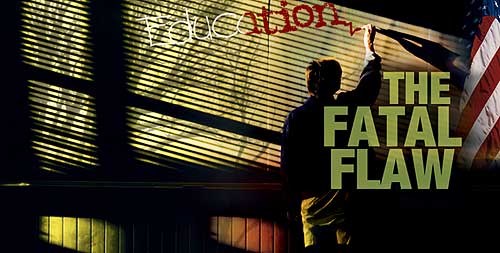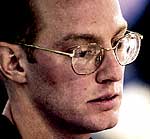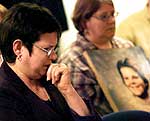
| ||
|
|
THE FATAL FLAW
A deadly incursion into America’s educational system two decades ago spawned a tragic murder. Problems have gotten worse. The families speak out.
By Thomas G. Whittle & Linda Amato
On a cold fall afternoon in 1986, two 14-year-old boys trudged through the snow and vanished into the New England woods.
Only one returned.
That boy, now a man, sits in the Shirley, Massachusetts Correctional Institution, convicted of murdering his companion by striking him five times in the head with a baseball bat.
While the assault lasted only a few minutes, it today still tortures the families of both victim and attacker.
In exclusive conversations with Freedom, the families of the killer, Rod Matthews, and his prey, Shaun Ouillette, spoke about what happened and why. Their thoughts have profound implications for students, parents and schools throughout America.
“That’s Like Me Doing Coke Every Day”
 His thoughts had begun to embrace monstrous concepts, unlike those of any normal schoolchild. Destructive acts followed — warning signs that his mental outlook, after years in the stranglehold of a drug, had taken a decidedly dark turn.
His thoughts had begun to embrace monstrous concepts, unlike those of any normal schoolchild. Destructive acts followed — warning signs that his mental outlook, after years in the stranglehold of a drug, had taken a decidedly dark turn.
|
Rather than getting to the bottom of whatever personal, health or learning difficulties Rod had that impelled him to goof around and distract others, his teacher turned to what was becoming an increasingly easy route — putting such kids on pills. The teacher reportedly told Rod’s parents, “Take him to the doctor. They can give him medication for this.”
There were no tests of any kind, his sister Judi said, no exams to see whether Rod could simply be an advanced student bored to death in the classroom. No medical screening was done to identify possible environmental toxins, nutritional deficiencies or allergies. Instead, he was labeled “hyperactive,” as have millions since, although the common tag these days is “Attention-Deficit/Hyperactivity Disorder” (ADHD).
The family doctor duly prescribed methylphenidate, an addictive stimulant regulated by the Drug Enforcement Administration (DEA) under the same strictures as amphetamines and cocaine, both of which it resembles in its chemical properties.
Thereafter, Rod frequently complained of how the drug hurt his stomach, one of the many side effects of methylphenidate. In addition, it is obvious now that more sinister changes had been set in motion.
Among other things, by 1986, Rod Matthews was no longer the class clown. He had been taking methylphenidate for nearly seven years. “That’s like me doing coke every day for seven years of my life,” said Judi. As the “speed”-type chemical solidified its grip, he had become silent, withdrawn and calculating.
“I Like to Do Crazy Things”
|
But while his body remained small, his thoughts had begun to embrace monstrous concepts, thoughts unlike those of any normal schoolchild.
In October 1986, a teacher saw Rod drop a note in a special “problem box” set up in his class so students could convey their troubles.
“My problem is I like to do crazy things. I’ve been lighting fires all over the place,” the note read. “Lately, I’ve been wanting to kill people I hate, and I’ve been wanting to light houses on fire. What should I do?”
Even a brief investigation would have detected warning signs that the mental outlook of the boy who had once “acted up” in class had, after years in the stranglehold of a drug, taken a decidedly dark turn.
In addition to setting fires, thoughts of suicide troubled the youth — something he never experienced before taking the drug.
As time progressed, Rod developed an unreasoning thirst to commit a violent act and murder grew closer to reality, going so far as to discuss possibilities with his two closest friends, Jonathan Cash and Robbie Peterson.
Rod finally selected a target — a new boy in the neighborhood, Shaun Ouillette — reasoning he “wouldn’t be missed.”
Yet, the warning signs — like the ominous letter in that teacher’s box — escaped unnoticed. The teacher failed to act, not believing Rod to be serious.
Then, on November 20, 1986, Rod’s thoughts exploded into action.



